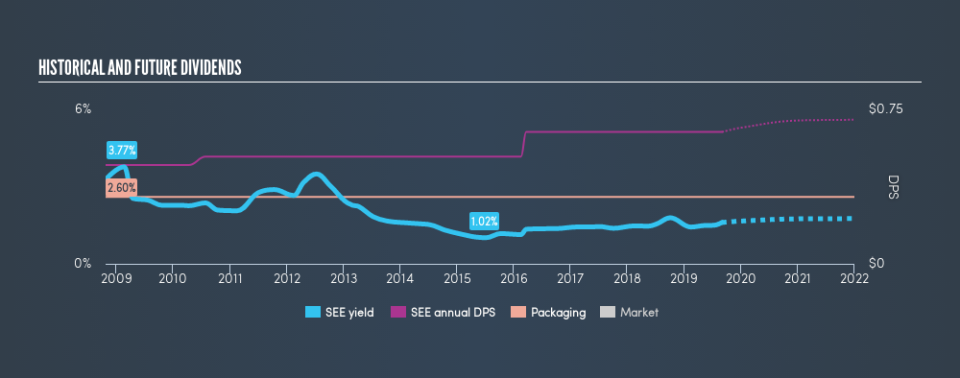There's A Lot To Like About Sealed Air Corporation's (NYSE:SEE) Upcoming 0.4% Dividend

Readers hoping to buy Sealed Air Corporation (NYSE:SEE) for its dividend will need to make their move shortly, as the stock is about to trade ex-dividend. You can purchase shares before the 5th of September in order to receive the dividend, which the company will pay on the 20th of September.
Sealed Air's next dividend payment will be US$0.16 per share, on the back of last year when the company paid a total of US$0.64 to shareholders. Based on the last year's worth of payments, Sealed Air stock has a trailing yield of around 1.6% on the current share price of $39.82. Dividends are a major contributor to investment returns for long term holders, but only if the dividend continues to be paid. So we need to investigate whether Sealed Air can afford its dividend, and if the dividend could grow.
View our latest analysis for Sealed Air
Dividends are usually paid out of company profits, so if a company pays out more than it earned then its dividend is usually at greater risk of being cut. Fortunately Sealed Air's payout ratio is modest, at just 27% of profit. Yet cash flows are even more important than profits for assessing a dividend, so we need to see if the company generated enough cash to pay its distribution. Thankfully its dividend payments took up just 27% of the free cash flow it generated, which is a comfortable payout ratio.
It's positive to see that Sealed Air's dividend is covered by both profits and cash flow, since this is generally a sign that the dividend is sustainable, and a lower payout ratio usually suggests a greater margin of safety before the dividend gets cut.
Click here to see the company's payout ratio, plus analyst estimates of its future dividends.
Have Earnings And Dividends Been Growing?
Stocks in companies that generate sustainable earnings growth often make the best dividend prospects, as it is easier to lift the dividend when earnings are rising. If earnings fall far enough, the company could be forced to cut its dividend. That's why it's comforting to see Sealed Air's earnings have been skyrocketing, up 37% per annum for the past five years. Earnings per share have been growing very quickly, and the company is paying out a relatively low percentage of its profit and cash flow. Companies with growing earnings and low payout ratios are often the best long-term dividend stocks, as the company can both grow its earnings and increase the percentage of earnings that it pays out, essentially multiplying the dividend.
The main way most investors will assess a company's dividend prospects is by checking the historical rate of dividend growth. Sealed Air has delivered 2.9% dividend growth per year on average over the past 10 years. It's good to see both earnings and the dividend have improved - although the former has been rising much quicker than the latter, possibly due to the company reinvesting more of its profits in growth.
To Sum It Up
From a dividend perspective, should investors buy or avoid Sealed Air? Sealed Air has been growing earnings at a rapid rate, and has a conservatively low payout ratio, implying that it is reinvesting heavily in its business; a sterling combination. It's a promising combination that should mark this company worthy of closer attention.
Curious what other investors think of Sealed Air? See what analysts are forecasting, with this visualisation of its historical and future estimated earnings and cash flow .
We wouldn't recommend just buying the first dividend stock you see, though. Here's a list of interesting dividend stocks with a greater than 2% yield and an upcoming dividend.
We aim to bring you long-term focused research analysis driven by fundamental data. Note that our analysis may not factor in the latest price-sensitive company announcements or qualitative material.
If you spot an error that warrants correction, please contact the editor at editorial-team@simplywallst.com. This article by Simply Wall St is general in nature. It does not constitute a recommendation to buy or sell any stock, and does not take account of your objectives, or your financial situation. Simply Wall St has no position in the stocks mentioned. Thank you for reading.

